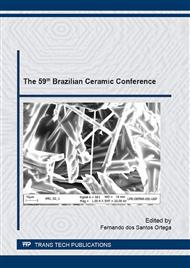p.410
p.416
p.422
p.427
p.433
p.441
p.447
p.453
p.459
Comparative Study of Geopolymeric Materials Using Different Precursors
Abstract:
To obtain geopolymeric materials, different waste materials can be used as precursors to be applied as sources of alumina and silica, which are activated by alkaline solutions. The aim of this study is to compare the obtainment of geopolymeric materials using different precursors, besides a single complementary source of silica (rice husk ash) and as an activator, the sodium hydroxide. After the geopolymeric materials synthesis, they were poured into cylindrical containers and cured in the incubator at 60 °C for 6 hours, followed by curing at room temperature for 7 and 28 days. The samples were characterized, and then it was proved the obtainment of geopolymeric materials through the formation of hydrated calcium silicate. Mechanical behavior showed that the resistances of the obtained materials have been affected in accordance with the composition of precursor used in the synthesis.
Info:
Periodical:
Pages:
433-437
Citation:
Online since:
November 2016
Keywords:
Price:
Сopyright:
© 2017 Trans Tech Publications Ltd. All Rights Reserved
Share:
Citation:


